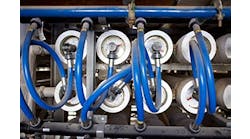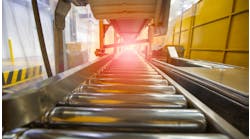Pumps are literally the heart of a food plant, moving vital fluids around. And as with human hearts, electronic monitoring of their condition can ensure continued health.
Digital technology has enhanced the performance and the maintenance of many kinds of industrial equipment, and pumps are no exception. The right kind of monitoring and control of pumps, and of the motors and drives that power them, can go a long way toward improving their performance and making sure they keep running.
Monitoring for various conditions would probably be the easiest kind of digital technology to implement, with the quickest payoffs. Monitors can assess temperature, vibration, power surges and ebbs and other conditions that can be indicative of potential (or immediate) problems.
Devices that monitor and control the motors that drive pumps can help run them efficiently and warn of trouble. Photo: ABB
“Monitoring of the motor with a smart sensor further increases the confidence in the analysis and decision making,” says Vijay Anand, sales manager for ABB Ability Digital. “Motor sensors also help in determining the loading on the motor, which provides valuable information on any inefficiency in operation of the drive train.”
Ability sensors can be attached to a pump or motor and monitored remotely, supported by artificial-intelligence software that, in Anand’s words, “looks into the data and tries to infer what is happening in the pump.”
Problems with centrifugal pumps – the kind most commonly found in food (and most other) plants – can include misalignment between motor and pump, bearing issues and turbulence. The last is indicative of operational problems such as cavitation – large air bubbles that can make the pump “run dry” for an instant, leading to potential long-term damage.
“The system would be more integrated, so that when that condition changes, that’s an indication to the user that something is happening in the pump...and they will have to start doing the next step of investigation to find out what is causing that and how it can be fixed,” Anand says.
Know your history
It's often necessary to analyze historical data from a given location to determine a baseline for analysis of performance parameters. These have to be chosen with care. If they’re set too low, the sensor will trigger constant false alarms that will lead floor personnel to ignore or even unhook it; if they’re set too high, the sensor becomes useless.
This is especially true for vibration, which is complex and prone to wide variances. It exists in three dimensions, it varies according to the speed or intensity of the machine’s operation, and it can be affected by environmental factors like the location’s acoustics and the proximity of other equipment.
That’s why it usually takes a specialist to set vibration limits. ABB recommends to customers that, after setting an initial baseline, customers look at 15 to 30 days’ worth of data and readjust vibration limits as needed.
The analysis that can be done with this kind of monitoring can enable users to practice predictive, as opposed to preventive or corrective, maintenance. Preventive maintenance is basically done on a rigid schedule that doesn’t take into account the current condition of a piece of equipment. It’s effective, but it wastes money on repairs or replacements of equipment that still has useful life left. Corrective maintenance incurs downtime costs when equipment breaks down and must be repaired or replaced.
Predictive maintenance, on the other hand, is potentially the most cost-effective approach. It uses artificial intelligence to analyze data from sensors to detect trends that can predict when equipment is likely to need attention, says Geoff Cresswell, product marketing manager for Busch Vacuum Solutions.
“Our solution is to use sensors to measure critical data points for the pump and process performance, and then run this data through smart algorithms to track pump and maintenance conditions,” Creswell says.
“An example of this is how we measure and analyze the temperature, inlet and exhaust pressure on an oil lubricated vacuum pump," he continues. "These pieces of data taken separately are fine to track the overall performance, but when taken and analyzed together we can precisely analyze oil and exhaust filter conditions, knowing the ideal time to perform service.”
Collecting data
This kind of monitoring depends on harvesting data from sensors and devices reliably. It’s possible to collect data manually, but it’s a tedious, time-consuming process, especially for pumps that are not easily accessible.
A far easier method is remote monitoring through the Industrial Internet of Things (IIoT). An IIoT network can harvest data in real time and send it to another location for analysis.
“The Internet of Things is a huge focus for us and for our technology partners,” says Justin Lesley, industry 4.0 innovation manager at Motion. “The most common application for these connected solutions is for continuous and remote monitoring of asset performance to facilitate predictive maintenance programs. Many of our customers use these technologies to track large numbers of assets from a single web-based dashboard, which is substantially more efficient than manual, route-based inspections.”
Devices like the Otto sensor from Busch can help form a profile of proper pump operation and detect when something goes out of spec.
The most common path to IIoT connectivity for maintenance monitoring is by attaching a monitor to equipment, such as ABB’s Ability or Busch’s Otto sensor.
“Otto combines hardware (including transducers/sensors and a wireless gateway), software (web dashboard, cellular app, smart algorithms), and Busch Service offerings,” Cresswell says. “What is being measured is dependent on the pump, but inlet and exhaust pressure, temperature and vibration sensors are common to all.”
Sensors can be concentrated on components that are the most liable to fail in a given application, such as bearings, which must be measured from relatively close since their energy doesn’t travel far, Anand says. ABB’s Ability software, which conducts remote analysis of Ability sensor data, can isolate factors like bearing noise to detect long-term trends.
Talking pumps
Digital control for pumps is, of course, not limited to maintenance issues. Like many other kinds of processing equipment, pumps can be wired into overarching software applications like manufacturing execution systems that manage the entire process. It’s largely a matter of making sure their controllers use a communication protocol that’s standard in the plant.
“Our Plus series vacuum pumps can communicate via Modbus, analog, or digital inputs,” Cresswell says. “And our vacuum systems, made with any pump technology, can be further adapted to fit any customer requirements. Common communication protocols such as ethernet, BACnet and Modbus can be utilized as requested.”
Digital control with the right kind of equipment can enhance a pump’s operation and make it more efficient. This is especially true with variable frequency drives (VFDs), which allow AC motors to vary their speed.
With pumps, a major reason to alter their speed is to have them deal with fluctuations in fluid pressure, which can occur as an infeed tank empties. For instance, as raw milk from a tanker truck gets pumped into a dairy plant, the incoming fluid pressure drops steadily as the truck empties.
These fluctuations can lead to bubbles that cause cavitation, which are liable to make a centrifugal pump run erratically as its impeller vanes encounter the air pockets. Cavitation can also be caused by interruptions of the flow upstream of the pump or by the pump’s impeller vanes not being the right size for the casing or the application.
ABB offers software for VFDs with an algorithm that can monitor a pump’s torque and identify its patterns, so that it can detect when cavitation is occurring and signal the pump to slow down until the bubbles subside.
This kind of speed adjustment also could be done by using sensors to measure flow and other parameters and wiring them into the pump’s controller. “But that would be more expensive because, of course, you need additional parts,” says Brith Isaksson, ABB global segment manager. “It is also so much smoother and faster if the VFD itself is controlling this.”
Pumps are a vital part of the plant, and they should be a part of any overall digital control plans. Digital control not only can keep pumps running, but can make sure they run as effectively as possible.


